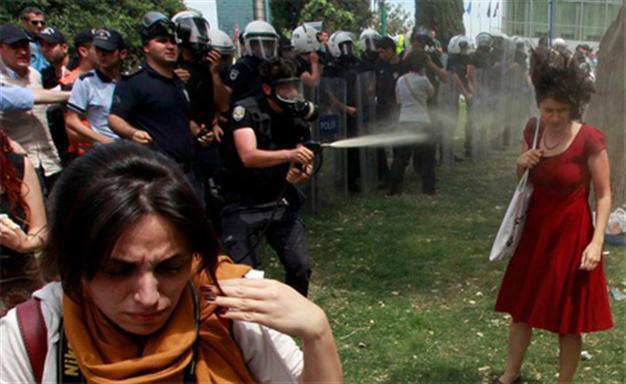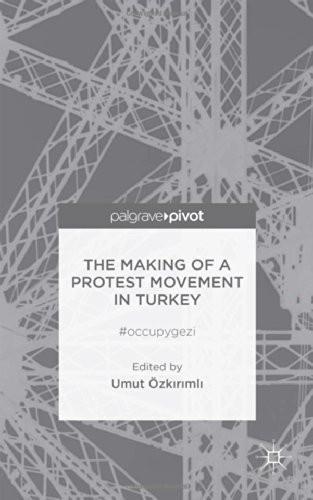The making of Turkey’s Gezi protests
William ARMSTRONG - william.armstrong@hdn.com.tr
 ‘The Making of a Protest Movement in Turkey: #occupygezi’ edited by Umut Özkırımlı (Palgrave Macmillan, £45, 176 pages)
‘The Making of a Protest Movement in Turkey: #occupygezi’ edited by Umut Özkırımlı (Palgrave Macmillan, £45, 176 pages)For many Turks, last summer’s Gezi protests were a kind of milestone - a before/after monument against which to measure everything else, in even the most unrelated aspects of life. Similarly, once the dam broke, Turkey’s political conversation was changed irreversibly; the protests and the government’s clumsy response meant that the narrative of Turkish politics would never be the same again. On the surface, however, little changed, and in subsequent months the levels of support for each of the main parties barely altered. The protests - in which more than three million Turks hit the streets in all but one of the country’s 81 provinces - had political origins, but in essence they were a social rather than political phenomenon.

“The Making of a Protest Movement in Turkey” is a collection of 10 essays on the demonstrations, penned by both foreign and Turkish academics. In his introduction, editor Umut Özkırımlı writes that the aim is to “offer a sober and critical reflection on the ‘eighteen days that shook the model’” and identify the “key problems Turkey will be grappling with in the near future.” The result is a curate’s egg: The range of subjects under consideration is wide, but it still leaves a few key stones unturned; and while the book’s best moments are full of insight, its worst are very thin indeed. It also suffers slightly from a restricted range of perspectives; all contributors are generally positive towards Gezi, and it surely wouldn’t do any harm to have a more ambivalent voice in there too - if only in the name of the diversity that Gezi itself prized.
The point about the protests’ limited impact on the mainstream political parties is worth emphasizing, but it shouldn’t be surprising. As Soli Özel writes in one of the pieces, Prime Minister Recep Tayyip Erdoğan continues to enjoy the electoral support of a majority, “but the significance of these events goes beyond electoral politics.” Similarly, Onur Bakıner writes that “the protests reflected frustration toward the entire political class and exclusionary political institutions.” Indeed, the idea that any one political party would be able to harvest the diverse energies and motivations of the protesters and direct them into a single platform is fanciful. It was easy to unite on the streets disparate groups that shared little other than their discontent, but it is almost impossible to build a coherent party-based platform from them now that the dust has settled. The significance of Gezi may well prove to be seismic, but the effects of the protests should be looked for anywhere other than in the established political parties.
The essays in this book generally do that, but some also remind me of why I’m reluctant to go back to academia. Judith Butler contributes a foreword so frustratingly Judith Butler that the reader’s sympathy for Gezi may be turned off from the word go. Later on, political scientist Zeynep Gambetti picks up the baton with a vapid piece on “Occupy Gezi as Politics of the Body”: “The physical presence of the bodies performatively enacted the demands that were being silenced through material and immaterial means by the forces of the state. It was as if the bodies were operating a kind of scission (or a de-cision) in a zone of indecision.” Such gobbledygook is doubly frustrating when the volume as a whole barely mentions the importance of social media. No doubt, the subject can be (and has been) overdone, but the way social media has revolutionized expectations among a small but significant constituency - particularly in Turkey, where the mainstream media has also become thoroughly discredited among so many - is one of the central stories behind Gezi. To barely mention it here seems a strange editorial choice.
Still, on the whole this is a thought-provoking and worthwhile read. One thing all contributors agree on is that the implications and the true significance of the protests may only become clear in years, perhaps decades. The park at the center of the storm may have been saved (if only temporarily), but the tendencies that roused the anger of the Gezi protesters have only accelerated since. Like the old regimes of Europe after the revolutions of 1848, the Erdoğan administration (regime?) has only tightened its iron grip on power. However, also like after 1848, the forces that those protests unleashed are sure to return further down the line; it only remains to be seen when and in what form.
 ‘The Making of a Protest Movement in Turkey: #occupygezi’ edited by Umut Özkırımlı (Palgrave Macmillan, £45, 176 pages)
‘The Making of a Protest Movement in Turkey: #occupygezi’ edited by Umut Özkırımlı (Palgrave Macmillan, £45, 176 pages) “The Making of a Protest Movement in Turkey” is a collection of 10 essays on the demonstrations, penned by both foreign and Turkish academics. In his introduction, editor Umut Özkırımlı writes that the aim is to “offer a sober and critical reflection on the ‘eighteen days that shook the model’” and identify the “key problems Turkey will be grappling with in the near future.” The result is a curate’s egg: The range of subjects under consideration is wide, but it still leaves a few key stones unturned; and while the book’s best moments are full of insight, its worst are very thin indeed. It also suffers slightly from a restricted range of perspectives; all contributors are generally positive towards Gezi, and it surely wouldn’t do any harm to have a more ambivalent voice in there too - if only in the name of the diversity that Gezi itself prized.
“The Making of a Protest Movement in Turkey” is a collection of 10 essays on the demonstrations, penned by both foreign and Turkish academics. In his introduction, editor Umut Özkırımlı writes that the aim is to “offer a sober and critical reflection on the ‘eighteen days that shook the model’” and identify the “key problems Turkey will be grappling with in the near future.” The result is a curate’s egg: The range of subjects under consideration is wide, but it still leaves a few key stones unturned; and while the book’s best moments are full of insight, its worst are very thin indeed. It also suffers slightly from a restricted range of perspectives; all contributors are generally positive towards Gezi, and it surely wouldn’t do any harm to have a more ambivalent voice in there too - if only in the name of the diversity that Gezi itself prized.